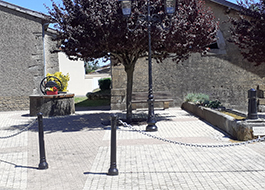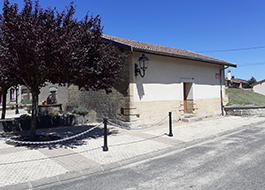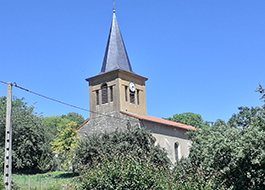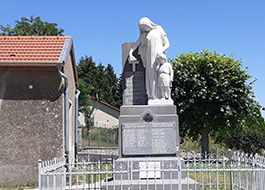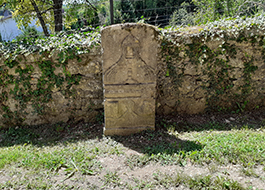Réville-aux-Bois
Durée visite : 40 minutes
Moyen : Pédestre
Le comté épiscopal de Verdun l’a reçu du duché de Luxembourg. Le village est affranchi en 1319. L’autorité royale française s’installe en 1659. Le choléra tue un habitant sur 8 en 1854. Riche en vignobles, Réville aurait posséder 7 alambics. Il ravitaillait tout le canton en alcool. La commune est saccagée par les Allemands en 14-18.
The episcopal county of Verdun received it from the Duchy of Luxembourg. The village was freed in 1319. The French royal authority was established in 1659. Cholera killed one inhabitant out of 8 in 1854. Rich in vineyards, Réville is said to have had 7 stills. He supplied the whole canton with alcohol. The town is ransacked by the Germans in 14-18.
Die Bischofsgrafschaft Verdun erhielt sie vom Herzogtum Luxemburg. Das Dorf wurde 1319 befreit. Die französische königliche Autorität wurde 1659 gegründet. 1854 tötete die Cholera einen von acht Einwohnern. Réville ist reich an Weinbergen und soll sieben Destillierapparate gehabt haben. Er versorgte den ganzen Kanton mit Alkohol. Die Stadt wurde 14-18 von den Deutschen geplündert.
Les points de visites
.
Survivances d’un passé pas si lointain, un puit et un abreuvoir ornent cette accueillante petite place. Saviez-vous que le t de puits a été ajouté au XVIe siècle, pour ne pas le confondre aves l’adverbe puis. Le plus ancien ouvrage connu en Egypte a été creusé il y a quatre mille ans.
Survivals of a not so distant past, a well and a drinking trough adorn this welcoming little square. The oldest known work in Egypt was dug four thousand years ago.
Überbleibsel einer nicht allzu fernen Vergangenheit, ein Brunnen und eine Tränke schmücken diesen einladenden kleinen Platz. Das älteste bekannte Werk in Ägypten wurde vor viertausend Jahren gegraben.
.
.
Les lavoirs avaient une importante fonction sociale. Ils constituaient en effet un des rares lieux où les femmes pouvaient se réunir et discuter. Interdits aux hommes, ces derniers s’inquiétaient des confidences et des commérages qui pouvaient s’y échanger. L’activité de nettoyage du linge était physiquement très difficile. Aussi, le fait de la pratiquer de façon collective la rendait plus facilement supportable : les femmes pouvaient discuter entre elles, plaisanter, chanter. Des conflits surgissaient également parfois, d’où l’expression laver son linge sale en famille, le lavoir réunissant la famille agrandie, celle du quartier ou du village.
Washhouses had an important social function. They were indeed one of the few places where women could meet and discuss. Prohibited to men, the latter worried about the secrets and gossip that could be exchanged there. The laundry cleaning activity was physically very difficult. Also, the fact of practicing it in a collective way made it more easily bearable: the women could discuss among themselves, joke, sing. Conflicts also sometimes arose, hence the expression washing dirty laundry with the family, the laundry bringing together the extended family, that of the neighborhood or the village.
Waschhäuser hatten eine wichtige soziale Funktion. Sie waren in der Tat einer der wenigen Orte, an denen sich Frauen treffen und diskutieren konnten. Männern verboten, sorgten sich letztere um die Geheimnisse und den Klatsch, die dort ausgetauscht werden könnten. Die Wäschereinigungstätigkeit war körperlich sehr anstrengend. Auch das kollektive Üben machte es erträglicher: Die Frauen konnten untereinander diskutieren, scherzen, singen. Manchmal kam es auch zu Konflikten, daher der Ausdruck Schmutzwäsche mit der Familie waschen, die Wäsche, die die Großfamilie, die Nachbarschaft oder das Dorf zusammenbringt.
.
L’église date du XVIIIe siècle. Le clocher est à portail latéral. Trois nefs sont soutenues par des colonnes doriques. Une statue géante en bronze de saint Pierre est présente dans le narthex. L’expression Saint Pierre aux liens fait référence à un épisode de la vie de l’apôtre Pierre. Celui-ci avait été arrêté et mis en prison par le roi Hérode. Il fut libéré miraculeusement par un ange.
The church dates from the 18th century. The bell tower has a side gate. Three naves are supported by Doric columns. A giant bronze statue of Saint Peter is present in the narthex. The expression Saint Peter in Bonds refers to an episode in the life of the Apostle Peter. He had been arrested and imprisoned by King Herod. He was miraculously freed by an angel.
Die Kirche stammt aus dem 18. Jahrhundert. Der Glockenturm hat ein Seitentor. Drei Schiffe werden von dorischen Säulen getragen. Im Narthex befindet sich eine riesige Bronzestatue des Heiligen Petrus. Der Ausdruck St. Peter in Bonds bezieht sich auf eine Episode im Leben des Apostels Petrus. Er war von König Herodes festgenommen und eingesperrt worden. Er wurde auf wundersame Weise von einem Engel befreit.
.
Il se situe à côté de l’église. Il représente La veuve et l’enfant éplorés – On lit Réville à ses héroïques Enfants Morts pour la France. La veuve est drapée à l’antique et elle jette des fleurs. Il a été inauguré en 1925. La commune a choisi d’honorer 4 soldats du 6e régiment colonial tombés à la reprise du pays, en les inscrivant aux côtés des soldats de Réville. L’auteur du monument est le belge Bodart, sculpteur à Longuyon depuis 1904. Il a réalisé 7 œuvres dans la région. 6 habitants de Réville sont morts à Grafenwöhr en Allemagne. Le camp a accueilli des prisonniers militaires, environ 18.000, mais aussi des civils (civils déportés des lieux de combats) dont des femmes et des enfants, environ 10.000 dont 2.000 français. Le camp était dans une ancienne caserne d’artillerie, il a été ouvert en août 1914.
It is located next to the church. It represents The grieving widow and child – We read Réville to his heroic Enfants Morts pour la France. The widow is draped in the antique style and she throws flowers. It was inaugurated in 1925. The town has chosen to honor 4 soldiers of the 6th colonial regiment who fell during the resumption of the country, by registering them alongside the soldiers of Réville. The author of the monument is the Belgian Bodart, sculptor in Longuyon since 1904. He produced 7 works in the region. 6 inhabitants of Réville died in Grafenwöhr in Germany. The camp accommodated military prisoners, approximately 18,000, but also civilians (civilians deported from places of combat) including women and children, approximately 10,000 including 2,000 French. The camp was in a former artillery barracks, it was opened in August 1914.
Es befindet sich neben der Kirche. Es stellt die trauernde Witwe und das Kind dar – Wir lesen Réville seinen heroischen Enfants Morts pour la France vor. Die Witwe ist im antiken Stil drapiert und wirft Blumen. Es wurde 1925 eingeweiht. Die Stadt hat beschlossen, 4 Soldaten des 6. Kolonialregiments zu ehren, die während der Wiedereroberung des Landes gefallen sind, indem sie sie zusammen mit den Soldaten von Réville registriert haben. Der Autor des Denkmals ist der Belgier Bodart, Bildhauer in Longuyon seit 1904. Er hat 7 Werke in der Region geschaffen. 6 Einwohner von Réville starben in Grafenwöhr in Deutschland. Das Lager beherbergte Militärgefangene, etwa 18.000, aber auch Zivilisten (Zivilisten, die aus Kampfgebieten deportiert wurden), darunter Frauen und Kinder, etwa 10.000, darunter 2.000 Franzosen. Das Lager befand sich in einer ehemaligen Artilleriekaserne und wurde im August 1914 eröffnet.
.
Une pierre tombale en calcaire, d’une hauteur de 1,56 m et de 56 cm de large avec une épaisseur de 11 cm, est adossée au mur ouest, devant l’église. La sculpture représente un autel orné d’une croix au centre, avec un calice et une écharpe posés dessus. Un drapé vient couvrir l’ensemble, à son sommet une forme de bonnet est surmontée d’une croix. Au bas de l’autel, une étole est croisée avec une croix à chaque extrémité. Il s’agit de la pierre tombale de Charles Mars (1725-1780) vicaire en 1751 puis curé en 1757, décédé le 20 janvier 1780, à l’âge de 55 ans, inhumé devant le portail de l’église Saint-Pierre-aux-Liens de Réville-aux-Bois.
A limestone tombstone, 1.56 m high and 56 cm wide with a thickness of 11 cm, leans against the west wall, in front of the church. The sculpture represents an altar decorated with a cross in the center, with a chalice and a scarf placed on it. A drape comes to cover the whole, at its top a shape of cap is surmounted by a cross. At the bottom of the altar, a stole is crossed with a cross at each end. This is the tombstone of Charles Mars (1725-1780), vicar in 1751 then parish priest in 1757, who died on January 20, 1780, at the age of 55, buried in front of the gate of the church of Saint-Pierre- at the Links of Réville-aux-Bois.
Ein Grabstein aus Kalkstein, 1,56 m hoch und 56 cm breit und 11 cm dick, lehnt an der Westwand vor der Kirche. Die Skulptur stellt einen Altar dar, der in der Mitte mit einem Kreuz geschmückt ist, auf dem ein Kelch und ein Halstuch platziert sind. Ein Vorhang bedeckt das Ganze, oben eine Kappe, die von einem Kreuz überragt wird. Am Fuß des Altars ist eine Stola mit einem Kreuz an jedem Ende gekreuzt. Dies ist der Grabstein von Charles Mars (1725-1780), 1751 Pfarrer, 1757 Pfarrer, der am 20. Januar 1780 im Alter von 55 Jahren starb, begraben vor dem Tor der Kirche Saint-Pierre- an den Links von Réville-aux-Bois.
.
Elle date de 1889. En France, la mairie est l’appareil administratif de la ville ou de la commune, qui est abritée dans le bâtiment surnommé hôtel de ville. Celui-ci comprend aussi la salle de délibération du conseil municipal, le lieu où l’on célèbre les mariages, ainsi que divers services comme l’état-civil, le dépôt du cadastre, l’urbanisme, la police municipale. Le terme désigne dans le code général des collectivités territoriales le siège de la municipalité. En pratique, les communes de taille importante utilisent souvent l’appellation hôtel de ville, le terme mairie désignant plutôt l’administration municipale rattachée au maire.
It dates from 1889. In France, the town hall is the administrative apparatus of the city or the municipality which is housed in the building nicknamed the town hall. It also includes the deliberation room of the municipal council, the place where marriages are celebrated, as well as various services such as civil status, the deposit of the cadastre, town planning, the municipal police, etc. The term designates in the general code of local authorities the seat of the municipality. In practice, large municipalities often use the term « town hall », the term « town hall » referring rather to the municipal administration attached to the mayor.
Es stammt aus dem Jahr 1889. In Frankreich ist das Rathaus der Verwaltungsapparat der Stadt oder Gemeinde, der in dem Gebäude mit dem Spitznamen Rathaus untergebracht ist. Es umfasst auch den Beratungsraum des Gemeinderates, den Ort, an dem Eheschließungen durchgeführt werden, sowie verschiedene Dienste wie Personenstand, Hinterlegung des Katasters, Stadtplanung, Stadtpolizei usw. Der Begriff bezeichnet im Allgemeinen Gemeindegesetzbuch den Sitz der Gemeinde. In der Praxis wird in großen Gemeinden häufig der Begriff „Rathaus“ verwendet, wobei sich der Begriff „Rathaus“ eher auf die dem Bürgermeister unterstellte Gemeindeverwaltung bezieht.





